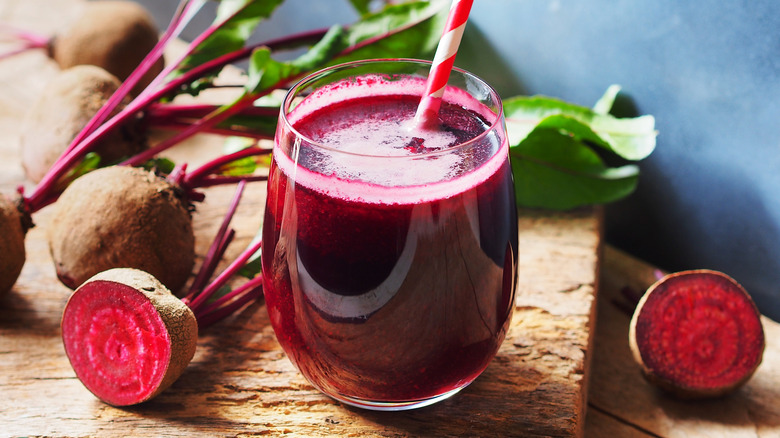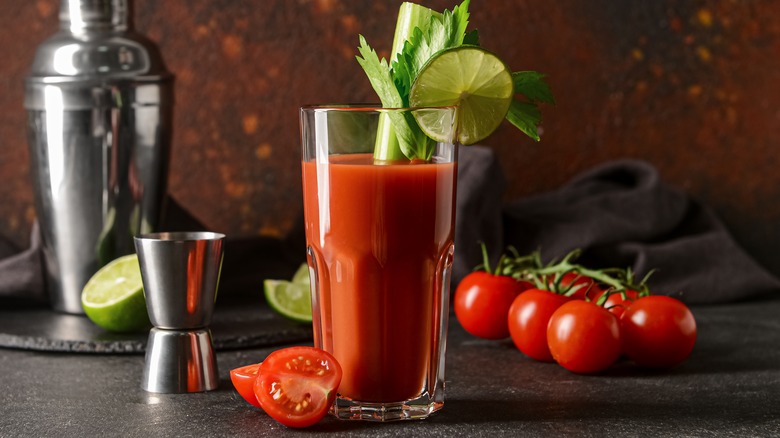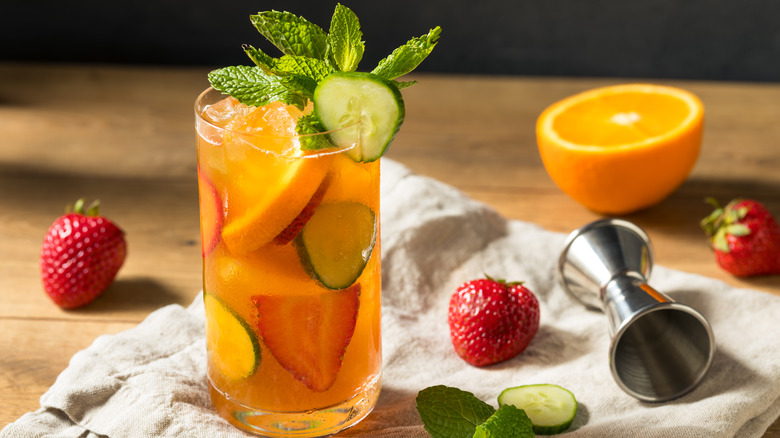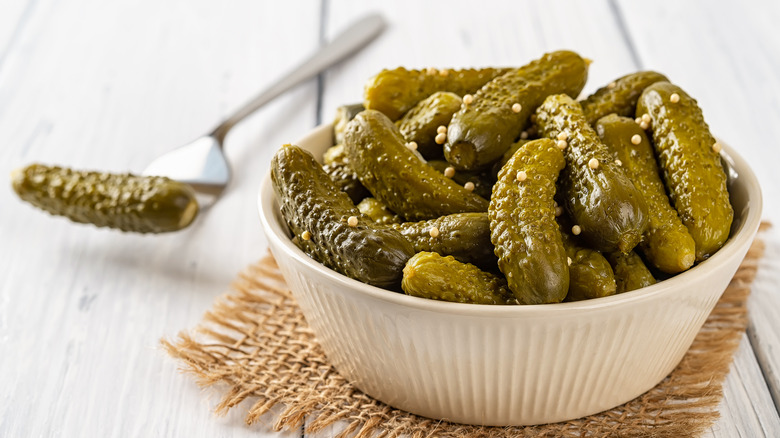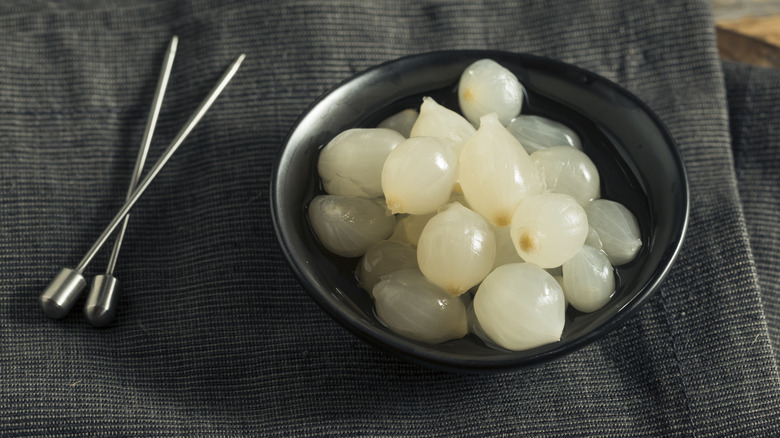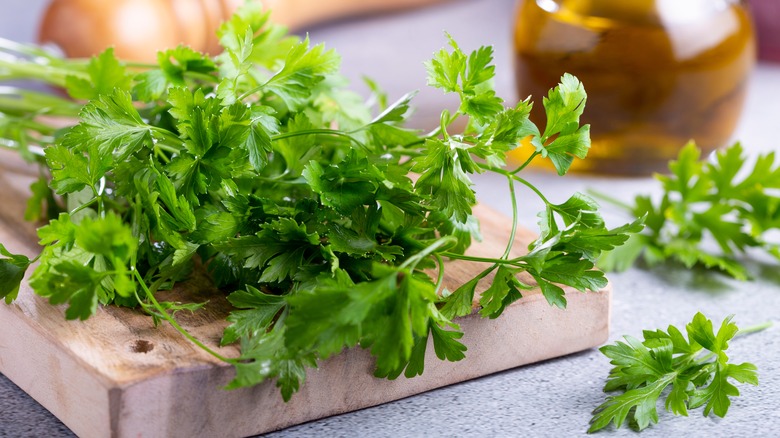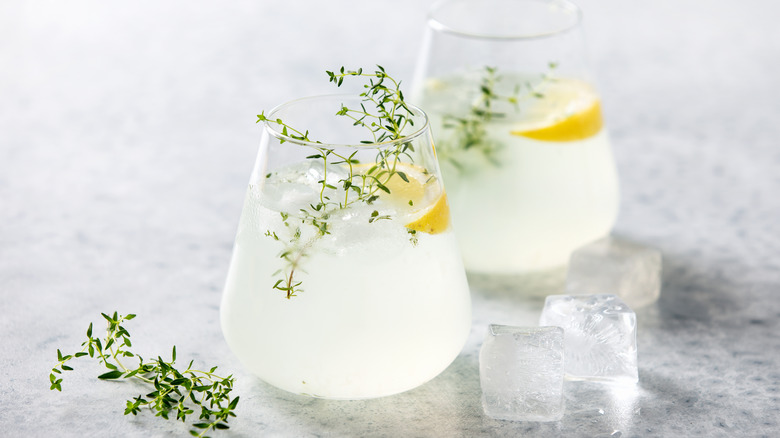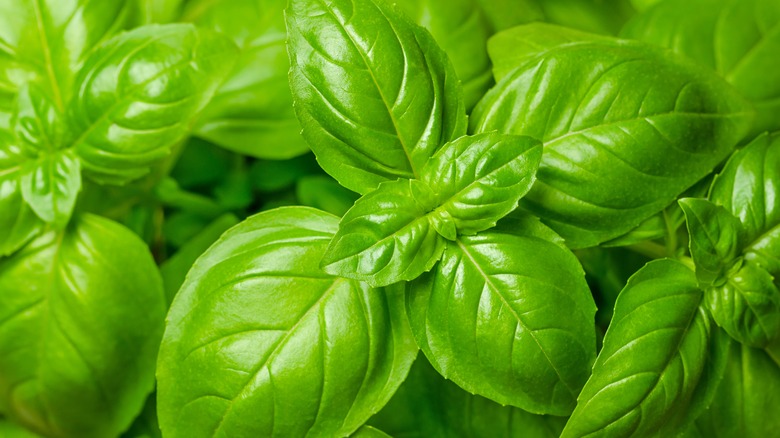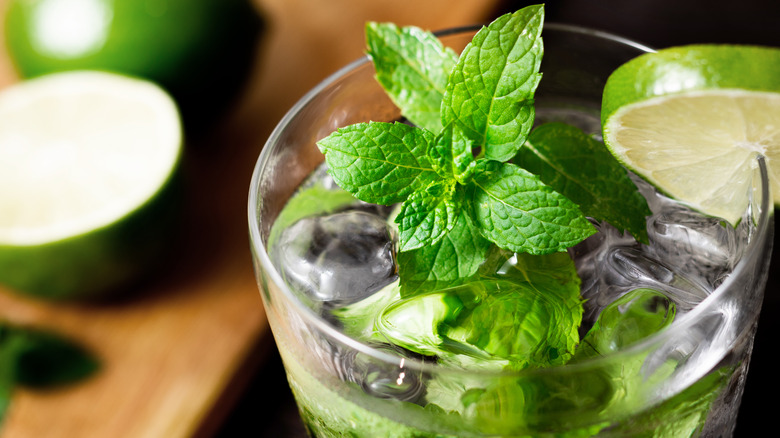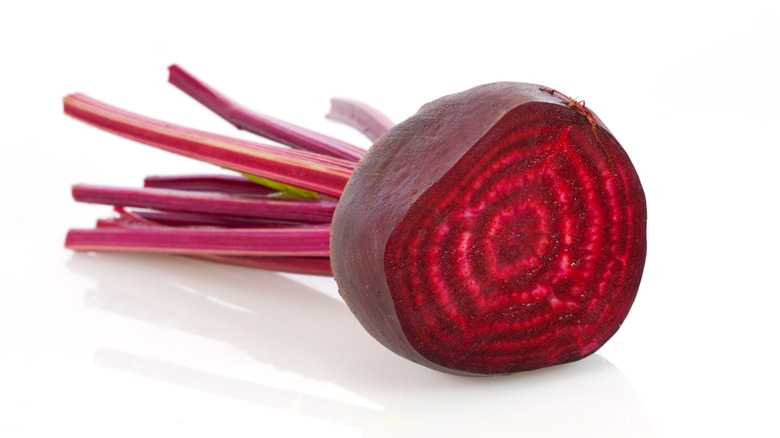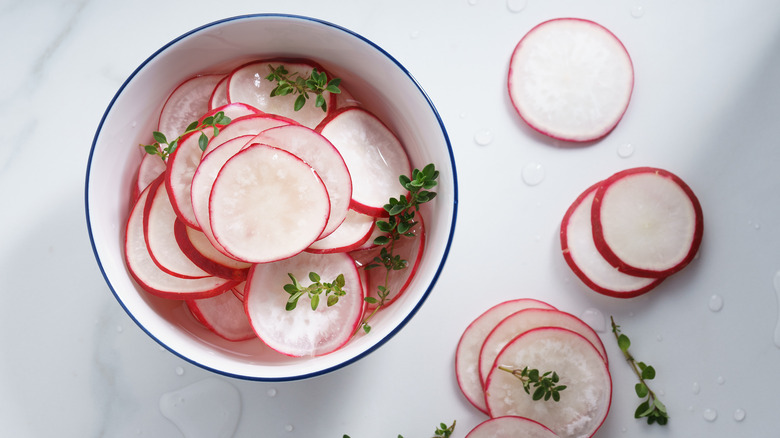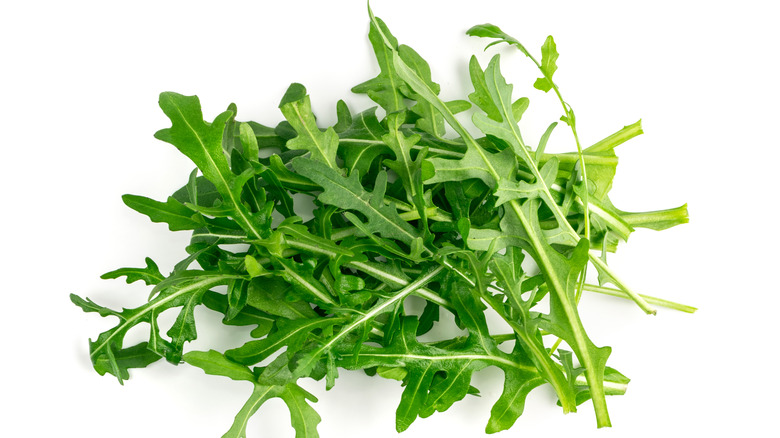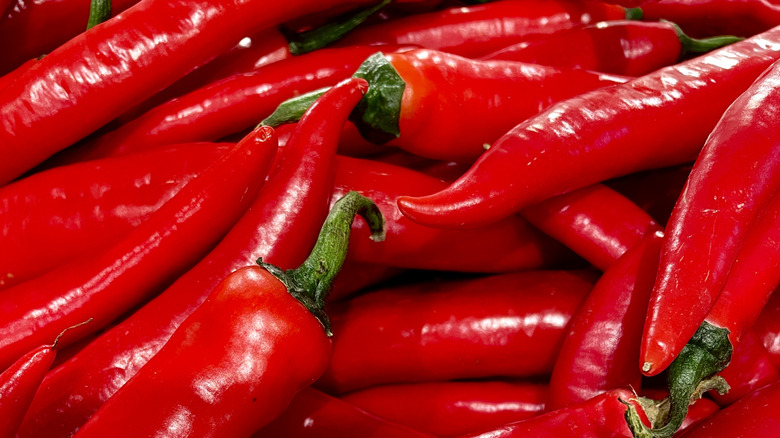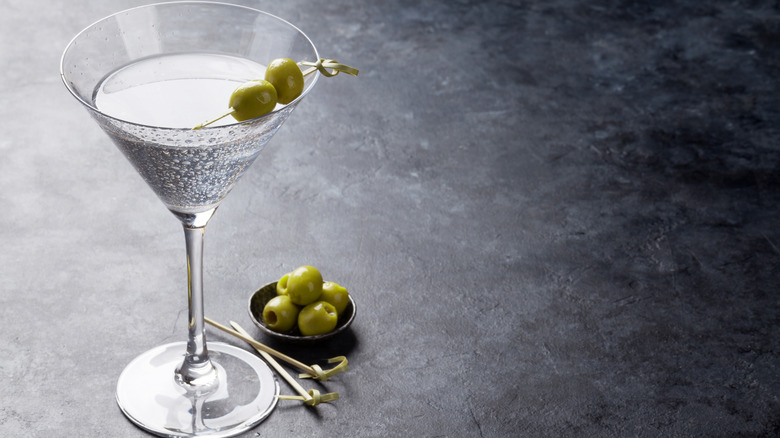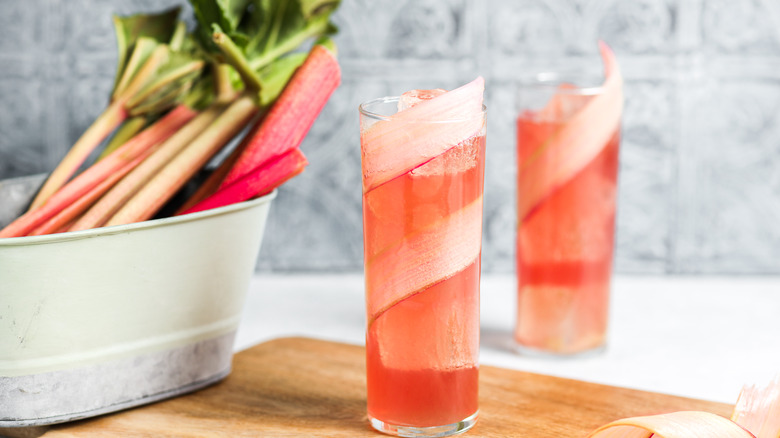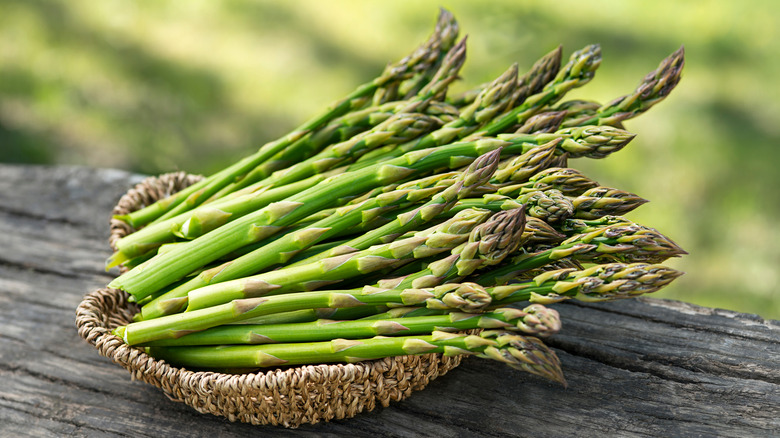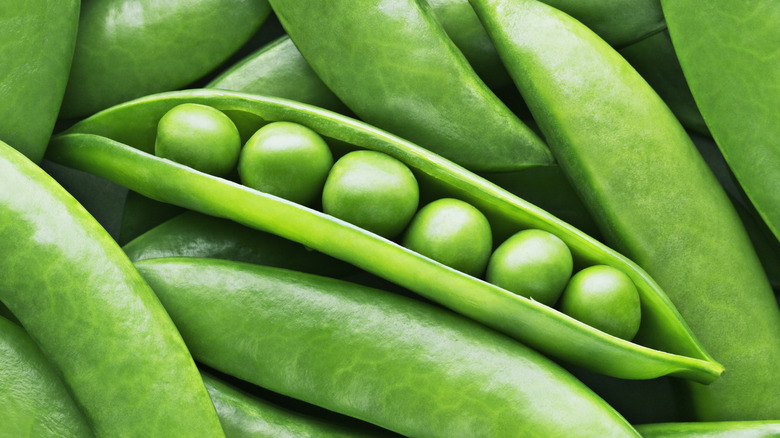16 Best Vegetables You Should Be Using To Garnish Cocktails
The presentation of a cocktail is part of its appeal. The color might be the first thing to strike the eye — a deep, sultry brown with a pop of orange or an unlikely purple shade, like a magical potion that promises to confer our heart's desire. But then our eyes focus on the garnish, which can range from the mundane to the outlandish and can make or break the overall look of a cocktail.
David Wondrich, author of "Esquire Drinks: an Opinionated and Irreverent Guide to Drinking," told the New York Times that references to cocktail garnishes had been found in English cookbooks as far back as the 18th Century, starting with commonly available fruits such as cherries. But adding a garnish didn't become widely popular until the Tiki-bar phenomenon exploded in the United States after prohibition. This was when things really started to get wild. Reported garnish sightings included gardenias, various parts of a pineapple, and the infamous paper parasol. The fruit was the preferred accouterment, and it remains so today. But as cocktail culture increasingly moves away from overly sweet drinks like Mai Tais and Pina Coladas, more sophisticated options with subtler flavors have started to appear. This is where the following vegetables can come in handy.
Celery
A Bloody Mary without the celery looks a bit scary, but the stalk is not just there for show. Celery salt is, in fact, a small but key ingredient in the making of Bloody Mary, along with vodka, tomato juice, Worcestershire sauce, lemon juice, and a dash of Tabasco sauce. The celery stick then highlights the taste of the celery while providing a clue as to what type of flavor to expect from this drink. But don't limit yourself to Bloody Marys, however well they may hit the spot at Mother's Day brunch. Try the Michelada, a Mexican-style version of the Bloody Mary that includes clam juice, and that was apparently developed in isolation from its well-known American counterpart. Because great minds think alike, this cocktail also lends itself well to additional garnishes, such as shrimp on skewers and jalapeno slices. It's basically a full meal packed with nutrients!
Fresh cucumber
Cucumber pairs extraordinarily well with gin. Some of the world's most popular gin brands are very cucumber-forward. Hendrick's gin, for example, a staple of upscale bars and trendy restaurants, is infused with rose, cucumber, and several other botanical elements. A cucumber garnish can thus steer the mind toward that subtle cucumber flavor in the gin. Not only that, but thinly sliced cucumbers look great as garnishes. Just take a mandolin, put it on a low setting, and slice lengthwise. You'll end up with a pale green sliver with a beautiful dark green pop that can be rolled up into an attractive curl or simply dropped into a drink as is.
Alternatively, you can take a very sharp knife and slice it into a paper-thin wheel. Use it as a garnish for a simple cucumber gin cocktail, in which you can also use the rest of the cucumber in muddled form, along with some simple syrup, gin, and fresh lime juice to make a Cucumber Gin Gimlet. You can also use it to accompany strawberries, orange slices, and whatever other fruit you want in a classic British Pimm's cocktail, which includes ginger ale, lemonade, and of course, Pimm's, a gin-based punch.
Pickles
Don't blindside your cocktail party guests with pickle juice. It's strong stuff. Announce its presence by garnishing your cocktail with an adorable little pickle. A fair warning will allow your drinking companions to get used to the idea of what's to come. Once they're in the zone, present them with a Fisherman's Folly garnished with that prophetic pickle. This cocktail of gin, sake, grapefruit juice, matcha tea powder, fish sauce, salt, and pickle juice sounds stranger than fiction, but it's a real cocktail, and it's worth a try. It's also a refreshing change from the usual sweet and fruity cocktail that can be found on practically any cocktail menu at any bar. But if Fisherman's Folly sounds too, well, foolish for a normal Tuesday night, try the simple Pickleback, which is a shot of whiskey of your choice followed by a shot of pickle juice. And don't forget to chase the lot with a pickle just to seal the deal.
Pickled onions
The best introduction to a pickled onion garnish is a Gibson. If you like Martinis, this will be a breeze. This classic cocktail may sound like a regular Martini at first glance, but it has its own twist on its parent version. That is, it doesn't have a twist at all. A classic dry Martini, which is made from five parts gin and one part vermouth, or a bottle of vermouth opened in the vicinity of your gin and waved in its general direction, typically comes with an olive or a lemon peel twist. The Gibson is basically that, but with a pickled onion, also known as a cocktail onion, as a garnish. And if you want to get creative with your drink, you can even make the pickled onions yourself. Just gather some onions of your choice, apple cider vinegar, garlic, Himalayan salt, and black peppercorns. Heat up the vinegar, salt, and pepper in a pan, add the onion and garlic, seal the container, and refrigerate for at least three hours. If you chose a large onion for this recipe, fold the strands onto your toothpick before garnishing your cocktail, or things could get messy.
Parsley
Lemon pairs well with cocktails, and parsley pairs well with lemons, so why not combine the lot in one big, merry cocktail? One of the best ways to do this is with a Mr. Hoopdriver. First, gather together an IPA of your choice, lemon soda, and most of your vegetable garden: a cucumber, 2 sprigs of fresh flat-leaf parsley, 2 sprigs of fresh rosemary, 2 sprigs of fresh sage, and 2 sprigs of fresh thyme. Combine the ingredients and steep, making sure the flavors blend in smoothly and thoroughly. Garnish with a full, leafy green parsley sprig for dramatic effect. Another experiment you can try is substituting the mint with parsley in this updated version of a Mint Julep. Instead of rubbing the julep tin with mint, use parsley, and then add fresh parsley leaves to garnish. In fact, you can substitute parsley for a number of different herb-based cocktails, as it's versatile and fresh, and we often have way more of it in our fridge than we actually need for any given dinner recipe.
Thyme
One of the fun things about thyme is that it comes in at least a dozen varieties, each with its own look, flavor, and appeal. There's lemon thyme, for example, that can add a citrusy flavor to your cocktail without an actual lemon in sight and has been known to keep a few mosquitoes at bay on a hot summer night. Caraway thyme tastes a bit like the eponymous seed, but it also comes with beautiful pink flowers — an ideal decoration for a light and fruity cocktail. And French thyme, a sweeter and more delicate herb than normal, everyday thyme, can give flavor to your cocktail without overpowering the rest of the ingredients. Any of these types can be used to make this lovely thyme-infused wine punch. Create your syrup by combining sugar, water, and 10 sprigs of thyme, then put together the punch itself with Vin de Savoie, lemon juice, cognac, cherry brandy, dry sparkling wine, ice cubes, and the thyme syrup you just made. Garnish with another sprig of thyme.
Basil
Sgroppino, a famous Italian palate cleanser, is often seen served with a basil leaf as a garnish. That's because Sgroppinos is all about freshening up the mouth after a heavy plate of pasta or a lengthy three-course meal. In fact, this simple cocktail is made up of some of the most refreshing ingredients known to humanity: a citrusy sorbet, or sometimes lemon gelato, which is lighter than ice cream as it contains less cream and more milk, Prosecco, and vodka or sometimes gin. And to pack an extra punch of flavor in your Sgroppino, be sure to tear up the basil leaves with your hands. Doing so by hand rather than with a knife will release the essential oils in a more effective way. Now you may be wondering why a light Mediterranean diet necessitates such a powerful palate cleanser, but the Sgroppino was actually born in the northern region of Veneto, where the diet can be much heavier, with staples such as meat stews and polenta.
Mint
Some consider it an herb, but on paper, it's a vegetable, even if it doesn't feel like one. Whatever the case, the possibilities are endless when it comes to using mint in cocktails and as a garnish. Let's take the classic mojito, for example. Start by making the syrup with sugar, water, and mint, and heating it up until the sugar is fully dissolved. More mint is then muddled at the bottom of the glass before being combined with the mint syrup, rum, lime juice, ice, and club soda. Then garnish liberally with one or more sprigs of mint. Another mint mainstay is the mint julep, where this herb — ahem — vegetable, is such an important component that the cocktail was actually named after it. Create a simple syrup and infuse it with mint leaves then, at the bottom of a glass or tin cup, muddle more mint leaves with the syrup, add some ice, and top it all with bourbon.
Beets
Beet-infused vodka is so unique it deserves its own garnish — a handsome little beet. With this drink, you'll want to lean into the deep purple color of beets and do everything you can to highlight it. The Conductor Cocktail calls for purple carrot juice, pineapple juice, and lemon juice, along with the beet-infused vodka. To complement the concoction, don't hold back on the garnishes. You can include a cucumber strip and a pickled purple carrot, but we recommend also thinly slicing a bright purple or orange beet and hanging it on the lip of your glass. This will amp up the color factor and complete the beet theme of this delicious cocktail. The good news is that you can even eat beets raw, making everything in your glass either drinkable or edible. And for an even more mesmerizing effect, try candy-striped beets, which will literally hypnotize you with their purple and white spiral pattern.
Radishes
With their pearly white interiors and bright red exteriors, radishes have a particular aesthetic charm that is rare in the vegetable world. Their peppery yet delicate flavor makes them downright magical, so it's no wonder Rapunzel's mother gave up her first-born daughter in exchange for a handful of radishes from the witch's garden. But we don't have to do that in the real world. We can just put the radishes in our cocktails and keep our children safe at home. Take the Red King, for example. It calls for shredded radish, which is muddled with sugar before being combined with gin, Cocchi Americano, grapefruit juice, lemon juice, bitters, and ice. Then garnish with thinly sliced radishes to double down on the peppery punch of this refreshing cocktail. And for an added touch of mystique, see if you can find a radish that comes in a different color, such as black, pink, or purple.
Arugula
If you don't like salads, don't worry. You can just get your leafy greens from your cocktails. Drinking vegetables in alcoholic form has been a growing trend in recent years, and it's no surprise that bartenders are getting creative with the type and range of vegetables they use as garnishes. We recommend focusing on arugula, which has a strong, peppery flavor and comes with an array of health benefits, including antioxidants, magnesium, and a slew of good, clean vitamins. You can choose between wild arugula, which has a strong, untamed flavor, as the name suggests, and baby arugula, which is softer and ideal as an introduction to this leaf. Over The Field is a great cocktail to start your health kick. You'll need to muddle the arugula with lemon juice and lime marmalade before adding your white rum and yellow chartreuse. A floating arugula leaf will complete the look.
Chili Peppers
Although peppers are technically fruit, they're most commonly used as vegetables in cooking across the globe — meaning they're primarily included in savory recipes. But that's no reason to miss out on this charred chili pepper and Aperol Spritz. The original Aperol Spritz is made up of Aperol, Prosecco, and soda water and was invented in the Veneto region of Italy in the 1950s. It is an ideal pre-dinner drink and is commonly taken as such in Italy, where it is also served with potato chips or other light snacks to whet the appetite for the upcoming meal. Since its inception, it has only grown in popularity and geographical reach, spawning new versions to accommodate any palate. One such variation is the aforementioned charred chili pepper and Aperol Spritz. Grill a few orange slices and fresh red chili peppers on high heat until charred, and then stick them in your classic Aperol Spritz. The spice and the char will appeal to your sense of smell as well as taste.
Olives
Another honorary vegetable is the olive. Olives complement the natural aromas found in gin and vermouth, so it's an obvious choice to garnish a Martini, which is famously made primarily with those two ingredients. And if you're making dirty martinis without putting olives in them as a garnish, you're doing something wrong. What you should be doing is combining your gin and vermouth with olive brine, pouring it into a glass pre-filled with ice, and stirring it all with a spoon. Or, if you're James Bond, put it all into a cocktail shaker and shake. Top it all off with an olive, or two, or three, or however many you can fit on your tiny little toothpick. You can also experiment with the type of olives you use. Manzanilla olives are a popular choice, while Castelvetrano olives, which are large, buttery and sweet, will give your teeth something to sink into.
Rhubarb
On the other hand, rhubarb is botanically a vegetable but is often used as a fruit in sweet recipes, such as strawberry-rhubarb pie. Its tartness makes it the perfect accompaniment to the sweet and sour cocktails that are in vogue today. A great example is the Kite Tail, made with rhubarb-infused simple syrup, mint leaves, bourbon, and dry white cider. A short stalk of rhubarb is perfect for decorating this drink, but stay away from the leaves! They may look like innocent leafy greens, but they're toxic to humans and can make people sick even in small doses, according to Disease-a-Month, a medical journal. Another option is the rhubarb spritzer, because we've already determined that we love spritzes. This fresh summer freeze of a drink involves combining rhubarb syrup with vodka and ice and topping it all off with Prosecco. You can use your stalk of rhubarb garnish to stir your drink every once in a while. You know, for dramatic effect.
Asparagus
Asparagus promotes liver health and is a recommended food to eat before a night of drinking. A study published in the Journal of Food Science found that the vegetable can more than double the activity of an enzyme that metabolizes alcohol, leading to lighter hangovers, if any, and the "protection of liver cells against toxic insults." So why not invite asparagus along to the party? For a really off-the-beaten-path Martini, try the Britney Martini, created with asparagus-infused vodka. Simply combine the vodka with manzanilla sherry and saline solution — not the kind where you store your contact lenses, but a food-grade solution created with two parts salt and one part water, which you can make yourself — and stir it in with the ice until condensation appears on your mixing glass. Then strain it into a Martini chalice and garnish with baby asparagus or the trimmed top of a daddy one.
Peas
You already know about the traditional mint Mojito, but let's not forget about this beautiful spring pea version. Mint and peas go so well together; they're like two peas in a pod, except that one of them is mint. Just muddle the peas along with the mint and sugar, as you would for a normal Mojito. The peas will create a creamier texture than you would normally get, leading to a slightly more substantial cocktail. Continue through the steps by adding rum, lime juice, simple syrup, and seltzer. And last but not least, skewer a few plump-looking peas with a cocktail pick and balance them over your glass — fresh peas straight out of the pod are the best option for this trick, as they'll be firm but not frozen solid. You may have to take the decoration off before you drink this refreshing mixture, but the presentation is undeniably pleasing.
